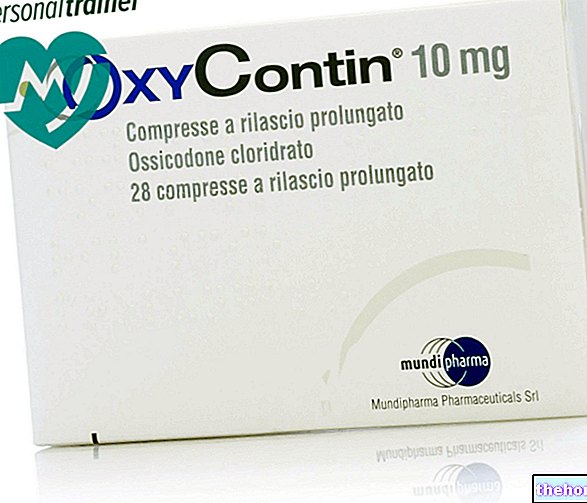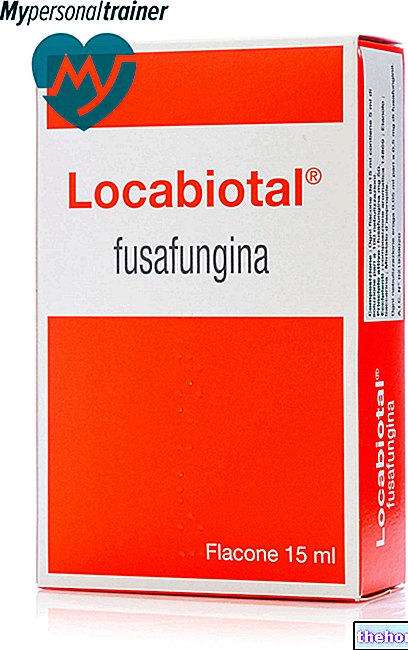Active ingredients: Vitamins A, Vitamin E
Rovigon chewable coated tablets
Indications Why is Rovigon used? What is it for?
Therapeutic category
Rovigon belongs to the therapeutic category of vitamins based on vitamin A and vitamin E.
Therapeutic indications
Rovigon is indicated in all deficient states due to malabsorption, especially lipid, or from malnutrition and related symptomatological pictures. Furthermore Rovigon, as a balanced association between vitamins A and E, is indicated in functional disorders and degenerative manifestations of tissues of epithelial and mesodermal origin (for example degenerative retinopathies, disorders of the inner ear, etc.), especially in people of middle age. and elderly.
Contraindications When Rovigon should not be used
Hypersensitivity to the active substance or to any of the excipients.
Hypervitaminosis A.
Children under 12 years of age.
Women who are pregnant or may become pregnant.
Precautions for use What you need to know before taking Rovigon
In order to avoid the appearance of signs and symptoms of overdosing, use the product under medical supervision and for the period of time deemed strictly necessary.
Preparations containing Vitamin E should be used with caution in diabetics and in people with heart failure as this vitamin can reduce the need for insulin and digitalis.
Interactions Which drugs or foods can modify the effect of Rovigon
Tell your doctor or pharmacist if you have recently taken any other medicines, even those without a prescription.
Vitamin E can enhance the action of digitalis or insulin.
Avoid concomitant use with other retinoid-containing medications or supplements and with antibiotics belonging to the tetracyclines class.
Warnings It is important to know that:
In very prolonged therapies, especially if for several years, do not exceed the number and duration of the therapeutic cycles recommended for each year, in order to avoid the risk of chronic overdosing of vitamin A.
In patients who smoke twenty or more cigarettes a day, prolonged use of the product may increase the risk of developing lung cancer.
During pregnancy, a daily intake of vitamin A of up to 10,000 IU has been shown to be safe.
However, doses above 15,000 IU / day have been associated with the possibility of malformations in humans. Therefore, daily dosages above 10,000 IU should be avoided during pregnancy, especially during the first trimester (see also "Pregnancy and lactation").
Vitamin A should not be taken together with other drugs containing vitamin A, the synthetic isomers tretinoin and etretinate or beta-carotene, as these compounds, in high doses, are considered harmful to the fetus.
In women of childbearing age it is necessary to ensure that:
- the patient is not pregnant when treatment is started (negative pregnancy test)
- the patient understands the teratogenic risk
- the patient agrees to use effective contraception without interruption for the duration of the treatment and for at least one month after its cessation.
Long-term treatments with vitamin A have been associated with cirrhosis, impaired hepatic circulation, hepatic fibrosis and hepatotoxicity. Patients with pre-existing liver disease are at increased risk of developing or worsening liver disease due to reduced production capacity of the retinol-binding protein. Patients taking high doses of vitamin A (greater than 2,500 IU / kg per day) for an extended period without interruption should be monitored for signs of hypervitaminosis A.
A maximum daily dose of 5,000 IU / kg should not be exceeded.
Before prescribing the treatment, the intake of vitamin A, isotrenitoin, etretinate and beta-carotene deriving from the diet and the possible use of supplements and concomitant drugs must be evaluated.
High doses of vitamin A have been associated with osteoporosis and osteosclerosis.
Pregnancy and breastfeeding
Ask your doctor or pharmacist for advice before taking any medicine.
Pregnancy
During pregnancy, a daily intake of vitamin A of up to 10,000 IU has been shown to be safe. However, doses above 15,000 IU / day have been associated with the possibility of malformations in humans. Therefore, in pregnancy, daily dosages above 10,000 IU should be avoided, especially during the first trimester. Vitamin A should not be taken together with other drugs containing vitamin A, the synthetic isomers tretinoin and etretinate or beta-carotene, since these compounds, in high doses, are considered harmful to the fetus.
In women of childbearing age it is necessary to ensure that:
- the patient is not pregnant when treatment is started (negative pregnancy test)
- the patient understands the teratogenic risk
- the patient agrees to use effective contraception without interruption for the duration of the treatment and for at least one month after its cessation.
Feeding time
There is no adequate information on the excretion of vitamin A and vitamin E in human and animal breast milk and therefore a risk to the suckling child cannot be excluded. The decision whether to discontinue breastfeeding or retinol / tocopherol therapy should be made while taking account of the benefit of breastfeeding for the infant and the benefit of retinol / tocopherol therapy for the mother.
Effects on ability to drive and use machines
The product can cause visual disturbances. If this happens, do not drive or operate machinery.
Important information about some of the ingredients
This product contains sucrose and glucose. Patients with rare hereditary problems of fructose or galactose intolerance, lactase deficiency, glucose-galactose malabsorption or sucrase-isomaltase deficiency should not take this medicinal product.
Dose, Method and Time of Administration How to use Rovigon: Posology
For oral use
Unless otherwise prescribed by the doctor, the recommended dose is one tablet per day for up to 4 weeks. The therapeutic cycle can be repeated throughout the year, in the opinion of the doctor.
The dosage should be adjusted on the basis of the serum levels of vitamin A and vitamin E. Rovigon is contraindicated in children under 12 years of age (see "Contraindications").
Overdose What to do if you have taken too much Rovigon
In case of accidental ingestion / intake of an excessive dose of Rovigon, notify your doctor immediately or go to the nearest hospital.
Acute hypervitaminosis A: Ingestion of excessive doses of retinol can cause acute vitamin A intoxication.
Factors influencing acute retinol toxicity reactions include age, nutritional status, type of preparation taken and route of administration. However, the risk may increase if you have kidney or liver disease, low body weight, protein malnutrition, hyperlipoproteinemia, alcohol consumption, or vitamin C deficiency.
Acute retinol toxicity is characterized by severe headache, dizziness, hepatomegaly, vomiting, irritability, somnolence and papilledema. Generalized peeling of the skin may occur after 24 hours. Skin reactions associated with retinol toxicity include cheilitis, facial dermatitis, exfoliative dermatitis, dry mucous membranes, hair structure changes, hair thinning, alopecia areata, generalized alopecia, rash, pruritus, skin fragility.
Other manifestations of an acute massive overdose consist of gastrointestinal symptoms (abdominal pain, nausea, vomiting) and pseudotumor cerebri (increased intracranial pressure with the following symptoms: headache, dizziness, numbness, papilledema and, in newborns, transient protrusion of the fontanelles), followed within a few days by generalized skin peeling. Generally, the signs and symptoms of vitamin A toxicity disappear rapidly with cessation of the intake.
Chronic hypervitaminosis A: prolonged intake of vitamin A at daily doses of 10 to 20 times the maximum recommended can cause the onset of hypervitaminosis A. The actual toxic dose depends on age, single doses and duration of administration. In adults, hypervitaminosis A generally results from the chronic intake of more than 30 mg of retinol per day; however, mild symptoms may occur already with a chronic daily dietary intake of 10 mg of retinol.
The symptoms of chronic vitamin A poisoning are varied and include headache, nausea and vomiting due to increased intracranial pressure, bone pain, signs and symptoms affecting the mucous membranes and skin, hepatomegaly, hypercalcemia, haematological changes. Skin may also occur. dry and itchy, erythematous dermatitis, cracking of the lips, anorexia, edema, haemorrhage, irritability and asthenia. Other possible symptoms are night sweats, abdominal discomfort, growth retardation, premature closure of the epiphyses, dizziness, alopecia, skin peeling, increased pigmentation skin, inflammation of the tongue, lips and gums.
Hepatotoxic reactions are present in about half of chronic hypervitaminosis A cases. In addition to clinical signs, such as hepatosplenomegaly, stellar angioma, leukonychia, palmar erythema and jaundice, an increase in hepatic transaminases (aspartate and alanine aminotransferases) is observed. The increase in alkaline phosphatase can be very marked and there can be cholestasis with hyperbilirubinemia. A reversible syndrome of portal hypertension with ascites can occur.
The only diagnostic laboratory finding is the increase in serum retinol levels, mainly in the form of retinyl esters.
Generally, the signs and symptoms of vitamin A toxicity subside rapidly upon discontinuation. In patients with impaired liver function and hepatomegaly the prognosis is usually favorable. However, if portal hypertension with ascites has developed, the syndrome may persist.
Vitamin E Overdose: Vitamin E is usually non-toxic. However, high doses (more than 300 units per day) have in rare cases caused nausea, diarrhea, intestinal cramps, asthenia, weakness, headache, blurred vision, rash, gonadal dysfunction, creatinuria, increased serum creatinine - kinase and creatinine-phospho-kinase, increase in serum cholesterol and triglycerides, increase in urinary estrogens and androgens and decrease in serum levels of thyroxine and triiodothyronine. These effects disappeared when the treatment was stopped. A meta-analysis found that doses of 400 units per day or more for a year or more were associated with increased all-cause mortality in patients with chronic disease. The results of this "data analysis were unclear about the risks and benefits of lower vitamin E dosages. However, a" dose-response analysis demonstrated a statistically significant relationship between vitamin E dosage and all-cause mortality. , with an increased risk at dosages above 150 units. These conclusions are controversial and are still a matter of debate in the medical and scientific community.
Very high doses of vitamin E (greater than 800 units per day for long periods) have also been associated with increased bleeding tendencies in patients with vitamin K deficiency, alterations in hormonal metabolism (thyroid, pituitary and adrenal glands), alterations in response and impaired sexual function and may increase thromboembolic risk in predisposed patients.
If you have any questions about the use of Rovigon, ask your doctor or pharmacist.
Side Effects What are the side effects of Rovigon
Like all medicines, Rovigon can cause side effects, although not everybody gets them.
The following undesirable effects have been reported in association with the use of Rovigon.
Eye disorders
Visual disturbances.
Gastrointestinal disorders
Gastrointestinal and abdominal pain, nausea, vomiting, diarrhea.
Hepatobiliary disorders
Jaundice, hepatomegaly, hepatic steatosis. Cirrhosis, liver fibrosis and hepatotoxicity have been associated with long-term vitamin A therapy (See "Warnings").
Disorders of the immune system
Allergic reaction, allergic edema, anaphylactic reaction, anaphylactic shock.Hypersensitivity reactions and related clinical and laboratory manifestations include mild to moderate reactions that can affect the skin, respiratory tract, gastrointestinal tract and cardiovascular system.
Diagnostic tests
Abnormal liver function tests, increased aspartate and alanine aminotransferase, increased blood triglycerides.
Metabolism and nutrition disorders
Hypercalcemia, lipid metabolism disorder.
Musculoskeletal and connective tissue disorders
Bone pain and osteoporosis; a high intake of vitamin A with diet or supplements has been associated with an increased osteoporosis and hip fracture risk.
Nervous system disorders
Headache. A "sudden onset of headache may be one of the symptoms of pseudotumor cerebri (see" Overdose ").
Skin and subcutaneous tissue disorders
Itching, hives, rash, dry skin, exfoliative dermatitis.
The following have been associated with chronic vitamin A use: alopecia, dermatitis, eczema, erythema, skin discoloration, hair structure changes, hypotrichosis, dry mucous membranes, skin fragility, cheilitis. Skin changes are often among the first signs of hypervitaminosis A.
Compliance with the instructions contained in the package leaflet reduces the risk of undesirable effects.
If any of the side effects gets serious, or if you notice any side effects not listed in this leaflet, please inform your doctor or pharmacist.
Expiry and Retention
Expiry: see the expiry date printed on the package.
The expiry date refers to the product in intact packaging, correctly stored. Warning: do not use the medicine after the expiry date shown on the package.
Medicines should not be disposed of via wastewater or household waste. Ask your pharmacist how to dispose of medicines you no longer use. This will help protect the environment.
Keep this medicine out of the reach and sight of children.
Composition and pharmaceutical form
Composition
One chewable coated tablet contains retinol 30,000 IU (as vitamin A palmitate 1.7 MIU / g with BHA / BHT), dl-α-tocopheryl acetate 70 mg (as vitamin E 50% CWS / S).
Excipients: sucrose, anhydrous glucose, mannitol, cocoa powder, low-fat milk powder, cocoa butter, povidone K30, glycerol, ethylvanillin, caramel flavoring, rice starch, talc, dried nebulized gum arabic, carmellose sodium, β-carotene (E 160a ) 10% CWS, solid paraffin, light liquid paraffin.
Pharmaceutical form and content
Chewable coated tablets.
Box of 30 tablets
Source Package Leaflet: AIFA (Italian Medicines Agency). Content published in January 2016. The information present may not be up-to-date.
To have access to the most up-to-date version, it is advisable to access the AIFA (Italian Medicines Agency) website. Disclaimer and useful information.
01.0 NAME OF THE MEDICINAL PRODUCT
ROVIGON CHEWABLE COATED TABLETS
02.0 QUALITATIVE AND QUANTITATIVE COMPOSITION
One chewable coated tablet contains: retinol 30,000 IU (as vitamin A palmitate 1.7 MIU / g with BHA / BHT), dl-α-tocopheryl acetate 70 mg (as vitamin E 50 CWS / S).
For the full list of excipients, see section 6.1.
03.0 PHARMACEUTICAL FORM
Chewable coated tablet.
04.0 CLINICAL INFORMATION
04.1 Therapeutic indications
Rovigon is indicated in all deficient states due to malabsorption, especially lipid, or from malnutrition and related symptomatological pictures.
Furthermore Rovigon, as a balanced association between vitamins A and E, is indicated in functional disorders and degenerative manifestations of tissues of epithelial and mesodermal origin (for example degenerative retinopathies, disorders of the inner ear, etc.), especially in people of middle age. and elderly.
04.2 Posology and method of administration
For oral use. Unless otherwise prescribed by the doctor, the recommended dose is 1 tablet per day for a maximum of 4 weeks.
The therapeutic cycle can be repeated throughout the year, in the opinion of the doctor. The dosage should be adjusted, based on the serum levels of vitamin A and vitamin E.
Rovigon is contraindicated in children below 12 years of age (see section 4.3).
04.3 Contraindications
Hypersensitivity to the active substance or to any of the excipients.
Hypervitaminosis A.
Children under 12 years of age.
Women who are pregnant or may become pregnant.
04.4 Special warnings and appropriate precautions for use
In order to avoid the appearance of signs and symptoms of overdosing, use the product under medical supervision and for the period of time deemed strictly necessary.
Preparations containing vitamin E should be used with caution in diabetics and in people with heart failure as this vitamin can reduce the need for insulin and digitalis.
In very prolonged therapies, especially if for several years, do not exceed the number and duration of the therapeutic cycles recommended for each year, in order to avoid the risk of chronic overdosing of vitamin A.
Due to the presence of beta-carotene in the composition, prolonged use of the product may increase the risk of lung cancer in heavy smokers (twenty or more cigarettes a day).
During pregnancy, a daily intake of vitamin A of up to 10,000 IU has been shown to be safe. However, doses above 15,000 IU / day have been associated with the possibility of malformations in humans. Therefore, daily doses above 10,000 IU should be avoided in pregnancy, especially during the first trimester (see also section 4.6).
Vitamin A should not be taken together with other drugs containing vitamin A, the synthetic isomers tretinoin and etretinate or beta-carotene, as these compounds, in high doses, are considered harmful to the fetus.
In women of childbearing age it is necessary to ensure that:
• the patient is not pregnant when treatment starts (negative pregnancy test)
• the patient understands the teratogenic risk
• the patient agrees to use effective contraception without interruption for the duration of the treatment and for at least one month after its cessation.
Long-term treatments with vitamin A have been associated with cirrhosis, impaired hepatic circulation, hepatic fibrosis and hepatotoxicity. Patients with pre-existing liver disease are at increased risk of developing or worsening liver disease due to reduced production capacity of the retinol-binding protein.
Patients taking high doses of vitamin A (greater than 2,500 IU / kg per day) for an extended period without interruption should be monitored for signs of hypervitaminosis A.
A maximum daily dose of 5,000 IU / kg should not be exceeded.
Before prescribing the treatment, the intake of vitamin A, isotrenitoin, etretinate and beta-carotene deriving from the diet and the possible use of supplements and concomitant drugs must be evaluated.
High doses of vitamin A have been associated with osteoporosis and osteosclerosis.
This product contains sucrose and glucose. Patients with rare hereditary problems of fructose or galactose intolerance, lactase deficiency, glucose-galactose malabsorption or sucrase-isomaltase deficiency should not take this medicinal product.
04.5 Interactions with other medicinal products and other forms of interaction
Vitamin E can enhance the action of digitalis or insulin.
Avoid concomitant use with other retinoid-containing medications or supplements and with antibiotics belonging to the tetracyclines class.
04.6 Pregnancy and lactation
Pregnancy
During pregnancy, a daily intake of vitamin A of up to 10,000 IU has been shown to be safe. However, doses above 15,000 IU / day have been associated with the possibility of malformations in humans. Therefore, daily dosages above 10,000 IU should be avoided during pregnancy, especially during the first trimester.
Vitamin A should not be taken together with other drugs containing vitamin A, the synthetic isomers tretinoin and etretinate or beta-carotene, as these compounds, in high doses, are considered harmful to the fetus.
In women of childbearing age it is necessary to ensure that:
• the patient is not pregnant when treatment starts (negative pregnancy test)
• the patient understands the teratogenic risk
• the patient agrees to use effective contraception without interruption for the duration of the treatment and for at least one month after its cessation.
Feeding time
There is no adequate information on the excretion of vitamin A and vitamin E in human and animal breast milk and therefore a risk to the suckling child cannot be excluded. The decision whether to discontinue breastfeeding or retinol / tocopherol therapy should be made while taking account of the benefit of breastfeeding for the infant and the benefit of retinol / tocopherol therapy for the mother.
04.7 Effects on ability to drive and use machines
The product can cause visual disturbances. If this happens, do not drive or operate machinery.
04.8 Undesirable effects
The adverse reactions listed below derive from spontaneous reports and therefore it is not possible to organize them by frequency categories.
Eye disorders
Visual disturbances.
Gastrointestinal disorders
Gastrointestinal and abdominal pain, nausea, vomiting, diarrhea.
Hepatobiliary disorders
Jaundice, hepatomegaly, hepatic steatosis.
Cirrhosis, hepatic fibrosis and hepatotoxicity have been associated with long-term vitamin A therapy (See section 4.4.).
Disorders of the immune system
Allergic reaction, allergic edema, anaphylactic reaction, anaphylactic shock.
Hypersensitivity reactions and related clinical and laboratory manifestations include mild to moderate reactions that can affect the skin, respiratory tract, gastrointestinal tract and cardiovascular system.
Diagnostic tests
Abnormal liver function tests, increased aspartate and alanine aminotransferase, increased blood triglycerides.
Metabolism and nutrition disorders
Hypercalcemia, lipid metabolism disorder.
Musculoskeletal and connective tissue disorders
Bone pain and osteoporosis; a high intake of vitamin A with diet or supplements has been associated with an increased osteoporosis and hip fracture risk.
Nervous system disorders
Headache. Sudden onset of headache may be one of the symptoms of pseudotumor cerebri (see section 4.9).
Skin and subcutaneous tissue disorders
Itching, hives, rash, dry skin, exfoliative dermatitis.
The following have been associated with chronic vitamin A use: alopecia, dermatitis, eczema, erythema, skin discoloration, hair structure changes, hypotrichosis, dry mucous membranes, skin fragility, cheilitis. Skin changes are often among the first signs of hypervitaminosis A.
Reporting of suspected adverse reactions
Reporting of suspected adverse reactions occurring after authorization of the medicinal product is important as it allows continuous monitoring of the benefit / risk balance of the medicinal product. Healthcare professionals are asked to report any suspected adverse reactions via the national reporting system. "address www.agenziafarmaco.gov.it/it/responsabili.
04.9 Overdose
Acute hypervitaminosis A: Ingestion of excessive doses of retinol can cause acute vitamin A poisoning.
Factors influencing acute retinol toxicity reactions include age, nutritional status, type of preparation taken and route of administration. However, the risk may increase if you have kidney or liver disease, low body weight, protein malnutrition, hyperlipoproteinemia, alcohol consumption, or vitamin C deficiency.
Acute retinol toxicity is characterized by severe headache, dizziness, hepatomegaly, vomiting, irritability, somnolence and papilledema. Generalized peeling of the skin may occur after 24 hours. Skin reactions associated with retinol toxicity include cheilitis, facial dermatitis, exfoliative dermatitis, dry mucous membranes, hair structure changes, hair thinning, alopecia areata, generalized alopecia, rash, pruritus, skin fragility.
Other manifestations of an acute massive overdose consist of gastrointestinal symptoms (abdominal pain, nausea, vomiting) and pseudotumor cerebri (increased intracranial pressure with the following symptoms: headache, dizziness, numbness, papilledema and, in newborns, transient protrusion of the fontanelles), followed within a few days by generalized skin peeling.
Generally, the signs and symptoms of vitamin A toxicity disappear rapidly with cessation of the intake.
Chronic hypervitaminosis A: Prolonged intake of vitamin A at daily doses from 10 to 20 times the maximum recommended can cause the onset of hypervitaminosis A. The actual toxic dose depends on age, single doses and duration of administration. In adults, hypervitaminosis A generally results from the chronic intake of more than 30 mg of retinol per day; however, mild symptoms may occur already with a chronic daily dietary intake of 10 mg of retinol.
The symptoms of chronic vitamin A poisoning are varied and include headache, nausea and vomiting due to increased intracranial pressure, bone pain, signs and symptoms affecting the mucous membranes and skin, hepatomegaly, hypercalcemia, haematological changes. Skin may also occur. dry and itchy, erythematous dermatitis, cracking of the lips, anorexia, edema, haemorrhage, irritability and asthenia. Other possible symptoms are night sweats, abdominal discomfort, growth retardation, premature closure of the epiphyses, dizziness, alopecia, skin peeling, increased pigmentation skin, inflammation of the tongue, lips and gums.
Hepatotoxic reactions are present in about half of chronic hypervitaminosis A cases. In addition to clinical signs, such as hepatosplenomegaly, stellar angioma, leukonychia, palmar erythema and jaundice, an increase in hepatic transaminases (aspartate and alanine aminotransferases) is observed. The increase in alkaline phosphatase can be very marked and there can be cholestasis with hyperbilirubinemia. A reversible syndrome of portal hypertension with ascites can occur.
Histopathological features include hypertrophy and hyperplasia of stellate (Ito) cells with accumulations of perisinusoidal lipocytes associated with fibrosis. Hepatocyte atrophy and cirrhosis have been reported. It is also possible to find a picture of hepatitis and steatosis. The risk may be increased with kidney or liver disease, low body weight, protein malnutrition, hyperlipoproteinemia, alcohol consumption, or vitamin C deficiency.
The only diagnostic laboratory finding is the increase in serum retinol levels, mainly in the form of retinyl esters. The concentration of the retinol binding protein (RBP) is normal and the excess retinol circulates bound to a lipoprotein.
Generally, the signs and symptoms of vitamin A toxicity subside rapidly upon discontinuation. In patients with impaired liver function and hepatomegaly the prognosis is usually favorable. However, if portal hypertension with ascites has developed, the syndrome may persist.
Vitamin E overdose: Vitamin E is usually non-toxic. However, high doses (more than 300 units per day) have in rare cases caused nausea, diarrhea, intestinal cramps, asthenia, weakness, headache, blurred vision, rash, gonadal dysfunction, creatinuria, increased serum creatinine - kinase and creatinine-phospho-kinase, increase in serum cholesterol and triglycerides, increase in urinary estrogens and androgens and decrease in serum levels of thyroxine and triiodothyronine. These effects disappeared when the treatment was stopped.
A meta-analysis found that doses of 400 units per day or more for a year or more were associated with increased all-cause mortality in patients with chronic disease. The results of this "data analysis were unclear about the risks and benefits of lower vitamin E dosages. However, a" dose-response analysis demonstrated a statistically significant relationship between vitamin E dosage and all-cause mortality. , with an increased risk at dosages above 150 units. These conclusions are controversial and are still a matter of debate in the medical and scientific community.
Very high doses of vitamin E (greater than 800 units per day for long periods) have also been associated with increased bleeding tendencies in patients with vitamin K deficiency, alterations in hormonal metabolism (thyroid, pituitary and adrenal glands), alterations in response and impaired sexual function and may increase thromboembolic risk in predisposed patients.
05.0 PHARMACOLOGICAL PROPERTIES
05.1 Pharmacodynamic properties
Pharmacotherapeutic group: vitamins.
ATC code: A11JA.
Vitamin A is the fundamental molecule for the synthesis of retinal purpura. Furthermore, it plays an essential role in the regulation of cell differentiation and proliferation processes, in particular for the normal function of epithelia and mucous membranes. Vitamin A is therefore used as a support therapy in the treatment of clinical manifestations related to morpho-functional alterations of the structures of epithelial origin (eg skin, mucous membranes, visual apparatus, inner ear, etc.). A vitamin A deficiency results in varying degrees of xerophthalmia, ranging from loss of night vision to photophobia or blindness. Vitamin A deficiency also causes impaired taste, smell and hearing and reduces resistance to infection.
Vitamin E carries out its main activity as a physiological antioxidant of lipid structures and as a stabilizer of cell membranes: it is therefore used as a support therapy in the treatment of various clinical manifestations related to toxic-oxidative vulnerability of biomembranes.
Vitamin E, as a natural antioxidant, protects vitamin A from oxidation, facilitating its use.
05.2 Pharmacokinetic properties
Vitamin A and vitamin E are absorbed in the intestine following the same mechanisms as fat-soluble substances.
10-30% of vitamin A (retinol) taken orally is not absorbed and is excreted in the faeces within 1-2 days. The main storage site of retinol is the liver, where 50 to 80% of the vitamin A present throughout the body is stored. The absorbed retinol is completely metabolized and converted into metabolites with hormonal activity. The metabolism of vitamin A involves oxidative and esterification, re-esterification, isomerization and conjugation processes. Retinol is oxidized in the retinal cytoplasm and acid all-tran- retinoic acid 13-Are you there-retinoic and their 4-oxo metabolites. The polar metabolites and glucuronides of retinol and retinoic acid are excreted in the urine and faeces.
The absorption and transport of vitamin E have been well characterized and described. Absorption from the intestinal lumen requires biliary and pancreatic secretions, the formation of micelles, the uptake by enterocytes and the secretion of chylomicrons. "taken by mouth, an absorption of 51-86% was calculated on the basis of faecal excretion. Following the uptake by the liver of the so-called" remnants "chylomicrons, which contain the just absorbed vitamin E, this is secreted by the liver in the VLDL lipoproteins. Vitamin E is present in most tissues and does not have a specific deposit site, being mainly localized in adipose and muscle tissues. Vitamin E is poorly metabolized. Due to its reduced intestinal absorption, the main route of excretion is represented by faecal elimination. About 1% of the oral vitamin E is excreted in the urine. The major urinary metabolites are 2, 5, 7, 8-tetramethyl-2 (2-carboxyethyl) 6-hydroxychromane (α-CEHC).
05.3 Preclinical safety data
The LD50 for intramuscular administration of vitamin A in monkeys is equal to 550,000 IU / kg, while for oral vitamin E in mice, rats and rabbits it is greater than 2000 mg / kg.
06.0 PHARMACEUTICAL INFORMATION
06.1 Excipients
Sucrose, anhydrous glucose, mannitol, cocoa powder, skim milk powder, cocoa butter, povidone K30, glycerol, ethylvanillin, caramel flavor, rice starch, talc, dried gum arabic spray, carmellose sodium, β-carotene (E 160a) 10 % CWS, solid paraffin, light liquid paraffin.
06.2 Incompatibility
Not relevant.
06.3 Period of validity
3 years.
06.4 Special precautions for storage
This medicine does not require any special storage conditions.
06.5 Nature of the immediate packaging and contents of the package
The chewable coated tablets are contained in blister packs of thermoformed plastic material coupled with aluminum tape, enclosed together with the package leaflet in a cardboard box.
06.6 Instructions for use and handling
No special instructions.
07.0 MARKETING AUTHORIZATION HOLDER
Bayer S.p.A. Viale Certosa 130, 20156 Milan
08.0 MARKETING AUTHORIZATION NUMBER
30 Chewable coated tablets AIC n ° 012812018
09.0 DATE OF FIRST AUTHORIZATION OR RENEWAL OF THE AUTHORIZATION
Renewal: 01 June 2010
10.0 DATE OF REVISION OF THE TEXT
AIFA determination of July 2015




























